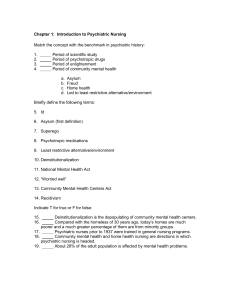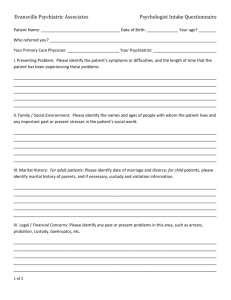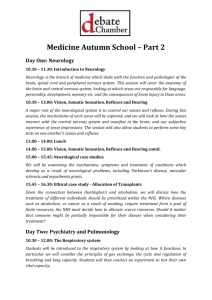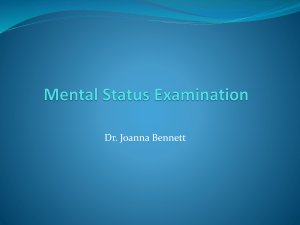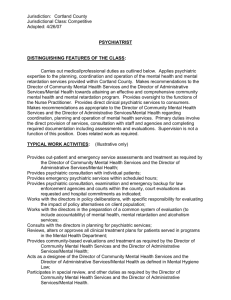I/2. The Psychiatric Examination 2.1. Overview of Psychiatric
advertisement
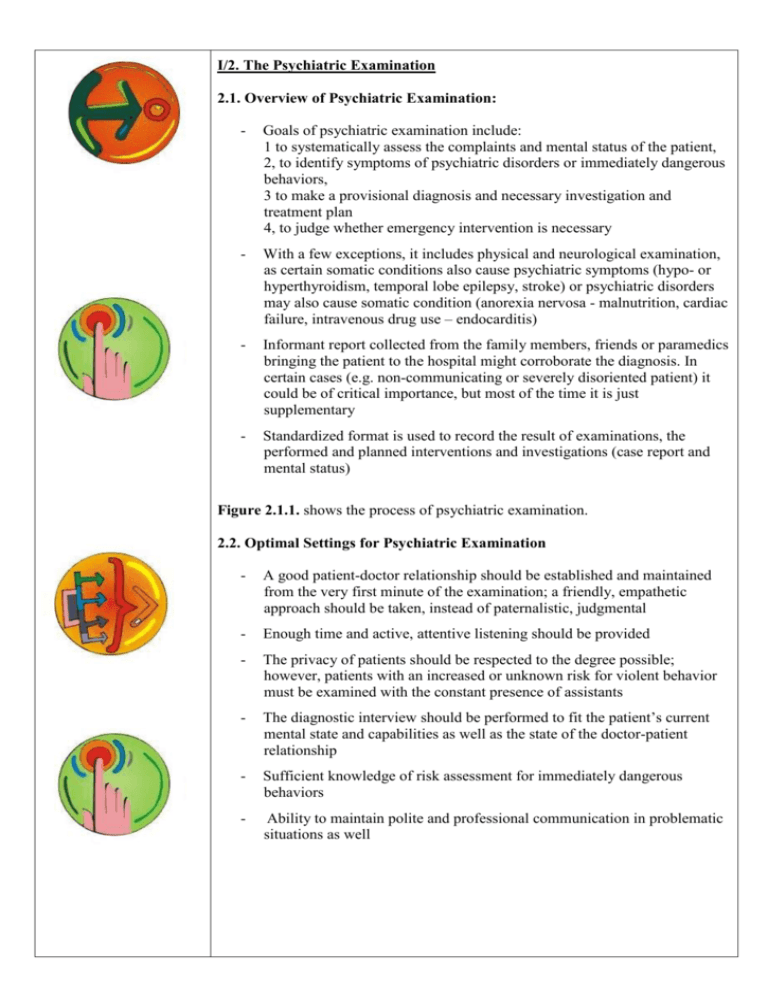
I/2. The Psychiatric Examination 2.1. Overview of Psychiatric Examination: - Goals of psychiatric examination include: 1 to systematically assess the complaints and mental status of the patient, 2, to identify symptoms of psychiatric disorders or immediately dangerous behaviors, 3 to make a provisional diagnosis and necessary investigation and treatment plan 4, to judge whether emergency intervention is necessary - With a few exceptions, it includes physical and neurological examination, as certain somatic conditions also cause psychiatric symptoms (hypo- or hyperthyroidism, temporal lobe epilepsy, stroke) or psychiatric disorders may also cause somatic condition (anorexia nervosa - malnutrition, cardiac failure, intravenous drug use – endocarditis) - Informant report collected from the family members, friends or paramedics bringing the patient to the hospital might corroborate the diagnosis. In certain cases (e.g. non-communicating or severely disoriented patient) it could be of critical importance, but most of the time it is just supplementary - Standardized format is used to record the result of examinations, the performed and planned interventions and investigations (case report and mental status) Figure 2.1.1. shows the process of psychiatric examination. 2.2. Optimal Settings for Psychiatric Examination - A good patient-doctor relationship should be established and maintained from the very first minute of the examination; a friendly, empathetic approach should be taken, instead of paternalistic, judgmental - Enough time and active, attentive listening should be provided - The privacy of patients should be respected to the degree possible; however, patients with an increased or unknown risk for violent behavior must be examined with the constant presence of assistants - The diagnostic interview should be performed to fit the patient’s current mental state and capabilities as well as the state of the doctor-patient relationship - Sufficient knowledge of risk assessment for immediately dangerous behaviors - Ability to maintain polite and professional communication in problematic situations as well 2.3. Psychiatric Status Psychiatric status provides a detailed, comprehensive description of the most relevant psychological functions, behavioral responses and psychopathological symptoms organized in structured manner, that records both the pathological symptoms and the physiologic functions/behaviors. A well-written status would precisely depict the patient’s current mental condition and indicates a pattern of affected functions by the time he/she was examined by the recording psychiatrist. Consciousness-related functions (Figure 2.3.1.): the awareness of self and the environment - consciousness alertness (vigility) és quality (integrity) - orientation (time, space, self, others) - attention alertness (vigility) and ability to sustain focus (tenacity) Perceptual functions (Figure 2.3.2.): Ability to detect and recognize stimuli: - perception formal (quantity, quality) and content by sensory modality Cognitive functions (Figure 2.3.3.): Ability to process, integrate/associate, learn and forget the perceived stimuli - thought formal/procedural (speed, structure) and thought content disorder - concept formation abstract thinking - memory: encode, store, retrieve - intellect: global cognitive ability Emotional (affective) functions (Figure 2.3.4.): An archaic, non-analytic information processing, reflects a subjective involvement and disposition - mood: the long-lasting emotional tone with no specific object - self-feeling: the emotional tone of perceiving oneself, no object - emotional reactions: object oriented reaction reflecting one’s involvement - impulse-control: strength of affect control - anxiety: vegetative, subjective, behavioral signs Volatile or response functions (Figure 2.3.5): Ability to initiate or respond actions - psychomotorium: planned motor activity, - volatile functions: motivation, activity, instinct-driven behavior - communication: verbal, non-verbal - complex behavior: social activity, value orientation, personality functions, attitude towards the examiner Risk factors: Symptoms that correlate with immediately dangerous behavior or efficacy of treatment - suicidal behavior: ideation, intention, past attempts - violent behavior:, verbal, physical hostility, previous actions - insight of illness: adequate, partial - critical sense/judgement: intact, diminished - reality-testing: ability to distinguish the objective/real contents from the subjective/fantasy elements or distortion 2.4. Structure of Psychiatric Case Report Personal data: patient identifiers Circumstances of admission: voluntary/involuntary, planned/emergency, events Present complaints: the chief complaints of the patient Exploration: the relevant part of the diagnostic interview, patient’s own word History: 1. Somatic, 2. Psychiatric: age at onset, history of past, relevant Present Status: 1. Internal, 2. Neurological 3. Psychiatric Status Summary: brief summary of the report Diagnosis: most likely diagnosis Differential diagnosis: other potential disorders with similar manifestation. Plan of Investigation: necessary tests for the diagnosis or treatment Plan of Treatment: potential biological, psychotherapies or sociotherapies 2.5. Psychiatric Statuses of the Example Cases Mental functions Consciousness functions Perceptual functions Cognitive functions Affective functions Volatile/Response functions Risk factors Ildikó (Case #1) András (Case #2) Clear consciousness, integrity preserved Attention can be drawn, directed, keeps the target idea and can change the subject oriented to time, place, examiner, self No indirect or direct sign of perceptual disturbance Thoughts at normal pace, no formal disturbances present, hoplessness and negative self-esteem, no other pathologic content. Ideas, concepts fit to educational level Intellect, and memory is according to his age Mood is at lower range, dysphoria, intensity of emotional reactions moderately decreased, but appropriate to the situation, impulse-control preserved, anhedonia, increased anxiety Psychomotorium: a bit slower, otherwise no formal or contentual disturbances. Speech is at average pace, logical, coherent. Gestures, mimic show lowered emotional expression. Hypobulia, lowered appetite, insomnia. Social activity decreased, no change in sexual activity. Personality functions are preserved, appearance is conventional, attitude conventional, cooperative. Hypervigil, altered consciousness, integrity decreased, Attention can be drawn, directed, have difficulties to keep the target idea and can change the subject oriented to time, place, examiner, self No indirect or direct sign of perceptual disturbance Thoughts at normal pace, but disorganized, tagentiality, ideas of reference, concretizations, persecutory delusions present. Intellect according to age, memory currently not evaluable Adequate insight of illness Preoccupation with death, but no suicidal ideation, plans, intention or previous attempt No risk for violent behavior Reality-testing is preserved Irritable mood, strong dysphoria, dull emotional reactions, apathy, anhedonia, impulse-control decreased, hightened, free-floating anxiety Psychomotorium: restless, agitated, no pathological content, mimic, gestures are poor, no emotional reactions, avoids eyecontact.. Speech is at average pace, coherence decreased. Severe hypobulia, ambivalence, ambitendendent. Insomnia, decreased appetite. Social activity greatly diminished, no change in sexual activity. Personality currently not evaluable. Appearance is neglected, behavior disorganized, driven by his delusions. Attitude is verbally dismissive but follows instructions No insight of illness. No suicidal ideation, intention or previous attempts Verbally hostile, and physical hostility towards family members Reality-testing severely impaired Summarizing questions: 1. What are the goals of the psychiatric examination? 2. Why admitting Ildikó (Case #1) to an inpatient treatment is necessary? 3. Why admitting András (Case #2) to an inpatient treatment is necessary even against his will? What are his symptoms that suggest the presence of a immediately dangerous behavior?


